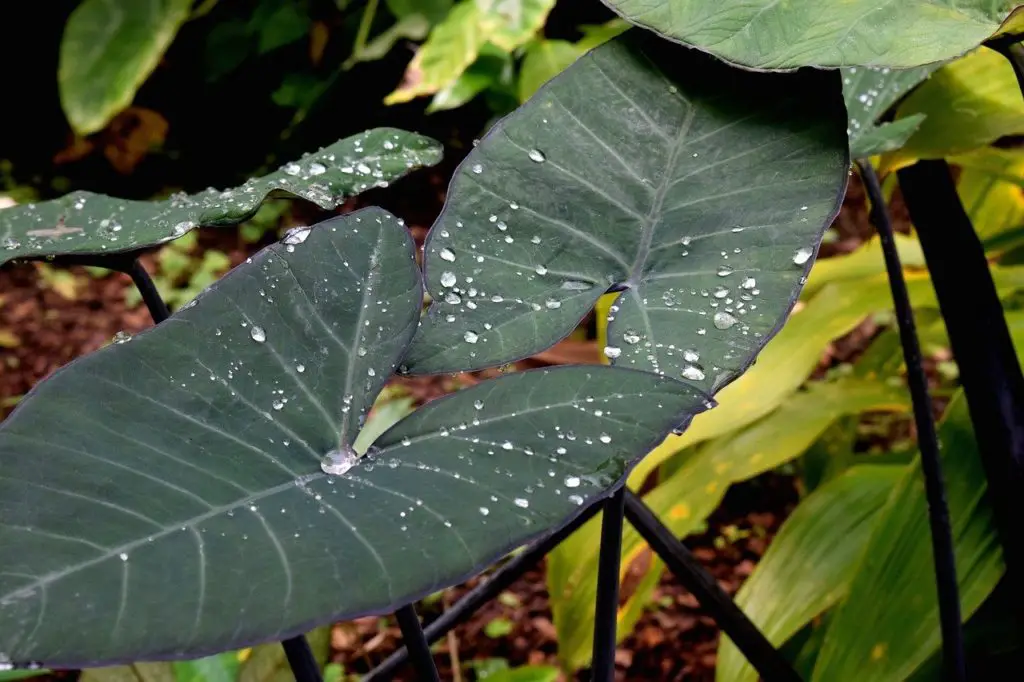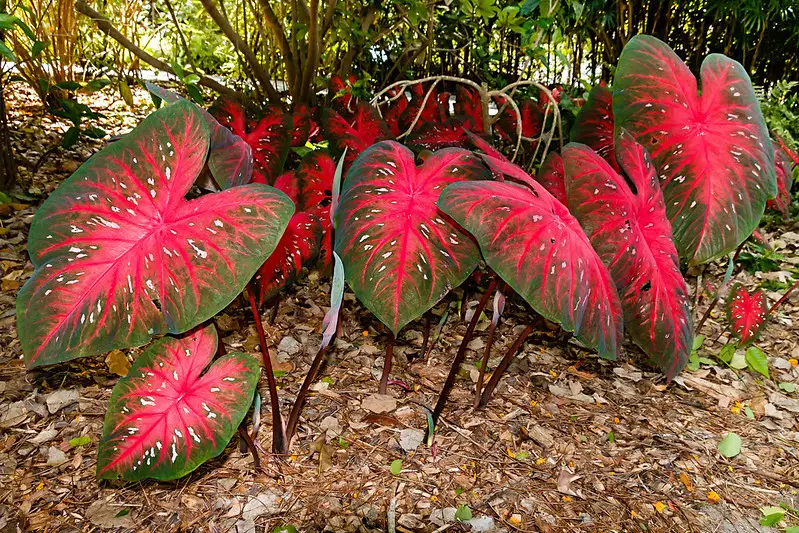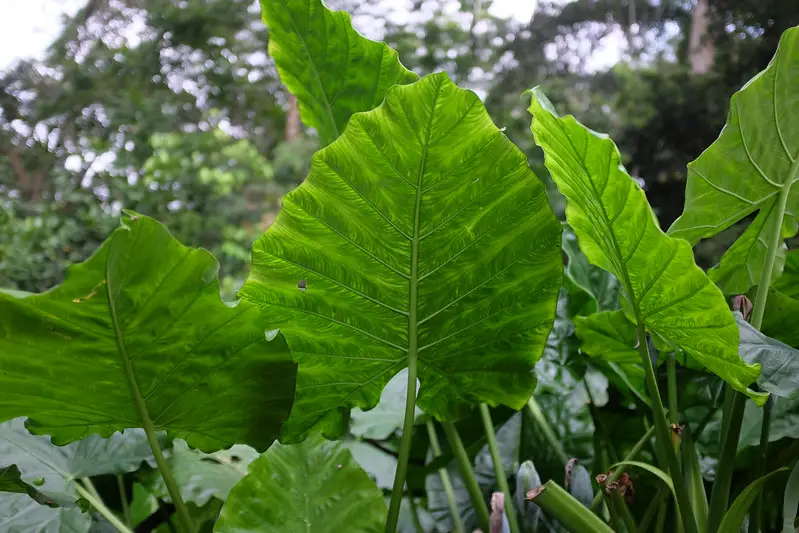We use affiliate links to run our site. When you buy through links on our site, we may earn an affiliate commission, without any added cost to you. Learn more
Do you want to add a touch of tropical flair to your garden? If so, then you need to check out elephant ear plants! These beautiful plants are known for their large, heart-shaped leaves, and they can add a touch of elegance to any space.
But how do you grow and take care of elephant ear plants? That’s what I’m going to show you in this post. I’ll cover everything you need to know, from choosing the right location to watering and fertilizing. By the end of this post, you’ll be an expert on elephant ear care!
So what are you waiting for? Read on to learn how to grow and take care of elephant ear plants!
What are elephant Ears:
Elephant ears are a type of tropical plant that is known for its large, heart-shaped leaves. They are native to Asia, Africa, and South America, and they can grow up to 8 feet tall. Elephant ears are popular ornamental plants, and they can be grown in the ground or in containers.
In A Nutshell
| Common Name | Elephant ears, elephant ear, taro, coco yam |
| Botanical Name | Colocasia, Alocasia, Xanthosoma, Remusatia spp. |
| Family | Araceae |
| Plant Type | Tropical perennial |
| Mature Size | Depends on variety; on average, 3–6 feet tall, with a similar spread, but smaller in colder climates |
| Sun Exposure | Full sun to part shade |
| Soil Type | Moist |
| Soil pH | Acidic (5.5 to 7.0) |
| Bloom Time | Late spring to early fall (rarely flowers) |
| Flower Color | Yellowish-white |
| Hardiness Zones | 8–10 (USDA) |
| Native Area | Asia, Australia, Central America, South America, Africa |
| Toxicity | Toxic to pets and humans |
| Light | Full sun to partial shade. Cultivars with darker leaves need more sun. |
| Soil | Rich, humusy, moist soil. Ideal for boggy areas or water gardens. |
| Water | Consistently moist. Can tolerate standing water but not soggy soil. |
| Temperature | Tropical plant. Evergreen in USDA zone 10 or warmer. Dies back in zones 8 to 9. |
| Humidity | Thrives in humidity. Tubers need to be stored in colder zones for the winter. |
| Fertilizer | Apply a water-soluble, high-nitrogen fertilizer every two to three weeks. |
| Propagation | Divide tubers at the end of the growing season. Store tubers for the winter. |
| Planting Depth | Plant tubers about 4 inches deep. |
| Spacing | Space plants at least 2 feet apart for smaller cultivars and 4 feet apart for larger varieties. |
Types of Elephant Ears:
Here are some of the most popular elephant ears:
Caladium:
Caladium is best for small gardens. They are not very tall up to (3 ft) and have a spread of about 2 feet. Some caladium can grow in the shade also. So these are a good choice if you want to grow elephant ears indoors.
Caladiums are native to South America. They are also called angel wings because of their amazing range of colors from green, white, or pink.
Alocasia:
They are native to Asia and Australia. The distinguishing feature of these plants is that unlike other elephant ears here the leaves point upwards. Alocasia is also called The African mask plant.
They can grow in partial shade and can reach heights up to 6 ft. The tubers of alocasia are not edible.
Colocasia:
Colocasia plants love humid and warm weather. They are native to India and Asia. They have edible tubers.
They are one of the tallest Elephant Ears and can reach a height of 10 ft with a huge leaf spread.
Alocasia vs Colocasia:
Although alocasia and colocasia leaves are quite similar, there are two subtle differences between the two.
Alocasia leaves point upward or grows horizontally, but colocasia leaves always point downward. Alocasia leaves are attached to the stem at the leaf notch, colocasia stems on the other hand attach below the leaf notch.
Xanthosaoma:
They are native to tropical America and love warm weather. Xanthosoma tubers are also edible. A Xanthosoma can reach a height of 4 ft.
Ideal Growing Conditions for Elephant Ears:
pH:
The ideal soil pH for growing elephant ears is between 5.5 and 7.0. Do a soil test before planting. If the soil pH is not in that range you can add various additives to bring the pH to that level.
Sunlight:
The need for sunlight in Elephant Ears varies from full sun to partial shade. Most of the varieties are grown in partial shade. Some darker varieties need full sun to grow.
Soil:
A uniformly moist soil that is rich in organic nutrients is ideal for growing Elephant ears. Add a generous amount of compost and manure to the soil.
These are heat-loving plants. If the soil temperature is cold, delay the planting. You usually want the soil temperature to be at least 65°F (18°C).
How to Plant Elephant Ears:
Choose the bulb carefully. The bulb should be large, plump, and firm. Remember, the bigger the bulb size bigger the plant and the bigger the leaves.
Plant the bulbs in the springs or after the danger of frost has passed. The Elephant ear bulbs sprout usually within 3-8 weeks. In warmer climates, the sprout will be faster than in cold climates. To fasten the process, start indoors, and once the environment warms up bring them outside.
Plant the Elephant Ear tubers at about 5 inches deep into the soil with the pointy side facing up. Cover it with soil and add water.
Elephant Ears Care (in general)

Fertilizing Elephant Ears:
These plants are voracious eaters. The best fertilizers for elephant ears are slow-releasing organic fertilizers. Bonemeal and Bloodmeal are two great choices for these plants. Stop fertilizing the plants in winter.
The Watering Schedule for Elephant Ears:
Elephant ears are water-loving plants. So make sure the soil remains moist and does not dry out, especially during the growing season. Keep watering regularly. Reduce the frequency of watering in winter.
If you are growing elephant ears in containers, water them daily during the summer. Give 2-3 inches of water per week.
Pruning Elephant Ears:
These plants produce new leaves very quickly during the growing season. So you have to prune and trim elephant ears regularly. Remove wilted, browning, or ratty leaves by cutting them off at the base of the plant.
Wear gardening gloves and long sleeves shirts while pruning elephant ears. The organic compounds in them can cause skin irritation in some people.
Elephant ear plants are toxic. The leaves and stems are the most toxic parts of the plants. They have poisonous oxalic acid crystals in their leaves and stems. Chewing or biting into this plant will release these crystals. The oxalic acid crystals then penetrate the tissue in the mouth and Gastro-Intestinal tract.
Upon contact, the plant can cause skin irritation. If you ingest it can cause swelling in the throat, mouth, and lips. It can also cause vomiting.
Are Elephant Ear Plants Edible:
Not all elephant ears are edible but some definitely are. You can eat the leaves and roots of colocasia. No part of the alocasia plant is edible, whereas colocasia leaves and roots are edible.
You should always eat elephant ears cooked, and not in the raw form. Cooking breaks down the crystals and makes them harmless. Also remember, some elephant ear species are more toxic than others.
So the plants that are used as a food source are not necessarily the same varieties that grow in your yard.

Are Elephant Ear Plants Invasive:
Elephant ears can be invasive. Their huge size can create problems for other plants that live under them.
As colocasia has a rapid growth rate, especially in warm conditions. It can become huge and can escape cultivation.
As even small fragments of the corms can reestablish and colonize natural areas, they can crowd out native species.
To minimize the issue choose the right growing location for the plant. Also, clean up those humongous leaves once they are dropped.
Common Pests and Diseases :
Some common diseases of Elephant Ears are:
Mosaic Virus Disease:
You will see uneven light and dark patterns on leaves once the plant is affected. Sometimes you can clearly see ring spots and the growth of the plant becomes stunted.
This virus is spread mainly by aphids. To control the spread remove infected plants immediately. Also, take steps to control aphids.
Root Rot Disease:
A number of pathogens cause root rots.
Improve the soil drainage. This is the only way to control root rot.
Here are some of the common elephant Ears pests
Aphids:
They feed on the undersides of the Elephant Ear leaves.
Use organic pest control techniques to fight aphid problems.
Mealybugs:
These are 1/8 to ¼ inch long flat wingless insects. They form cottony-looking masses on stems, branches, and leaves and suck the juices from leaves and stems. This causes weak plant growth.
Wash the infected plant parts. Use predator insects to control the bug population.
Root Maggots:
These white maggots feed on the roots and cause wilted leaves. They also leave brown tunnels in the root.
Use organic pest control methods to control maggots.
Spider Mites:
Spider mites suck on the plant juice. They cause white dots on the foliage. You can also see webbing on the plant. With time The foliage will turn yellow and become dry.
Use insecticidal soaps and other organic pest control methods to control the population.
What to Grow With Elephant Ears:
Different elephant ear plants have different leaf colors and shapes. So you can try other plants to grow with elephant ears.
Some cool choices are ferns of contrasting colors, begonias, and plants with smaller leaves.
Some Tips and Tricks For Growing Elephant Ears:
- If you love elephant ear plants, but you’ve got young children or pets, you might try a few strategies to prevent accidental poisoning.
- Place the plants where they’re out of reach.
- Grow the plants in the front yard, rather than the backyard, where children and pets are more likely to play.
- Teach your kids not to touch or eat any plant in the yard.
- You can grow smaller varieties of elephant plants in hanging containers. And remove any fallen leaves as soon as you see it!
Final Thought:
Elephant ear plants are beautiful and easy to grow, making them a great choice for any gardener. By following the tips in this post, you can have healthy and thriving elephant ears for years to come.
Here are some additional tips to help you care for your elephant ears:
- Protect your elephant ears from frost in the winter. If you live in a cold climate, you may need to bring your plants indoors during the winter.
- Inspect your elephant ears regularly for pests and diseases. If you see any problems, treat them immediately.
- Divide your elephant ears every few years to keep them healthy and vigorous.
I hope you enjoyed this post! If you have any questions, please leave a comment below. And be sure to share this post with your friends and family.
Also, be sure to explore our website for more gardening tips. We have a wide variety of articles on everything from plant care to landscaping.
Finally, take action and start growing your own elephant ear plants today! You won’t be disappointed.
Like the post? Don’t forget to PIN IT

How big do elephant ears get?
The size of elephant ears depends on the type of plant and the growing conditions. However, most elephant ears will grow to be at least 3 feet tall and wide.
How long do elephant ears live?
Elephant ears can live for several years if they are properly cared for. However, in colder climates, they may only live for one season.
Can I grow elephant ear plants indoors?
Yes, elephant ear plants can be grown as houseplants, as well as large outdoor plants in warmer weather.
What are the popular types of elephant ear plants?
The popular types of elephant ear plants include colocasia, alocasia, xanthosoma, and caladium. They are known for their dramatic impact and lush foliage.
Can I propagate elephant ear plants?
Yes, elephant ear plants can be propagated through division. The tubers can be divided at the end of the growing season and stored for the next season.
Can I grow elephant ear plants from seeds?
While elephant ear plants can be grown from seed, it is not the preferred method. Sprinkling the seeds on top of a seed-starting mix and keeping it damp can help with germination.
What should I do with elephant ear plants in colder climates?
In colder climates, elephant ear plants can be dug up before the first frost and stored in a cool, dry place for overwintering. They can be replanted in the spring once the threat of frost has passed.
Can elephant ear plants bloom?
Yes, elephant ear plants can bloom, usually by the third growing season if they have ideal growing conditions. However, most gardeners remove the flowers to encourage leaf growth.
Amazon and the Amazon logo are trademarks of Amazon.com, Inc, or its affiliates.

Hi there! My name is Prasenjit and I’m an avid gardener and someone who has grown a passion for growing plants. From my hands-on experience, I have learned what works and what doesn’t. Here I share everything I have learned.
